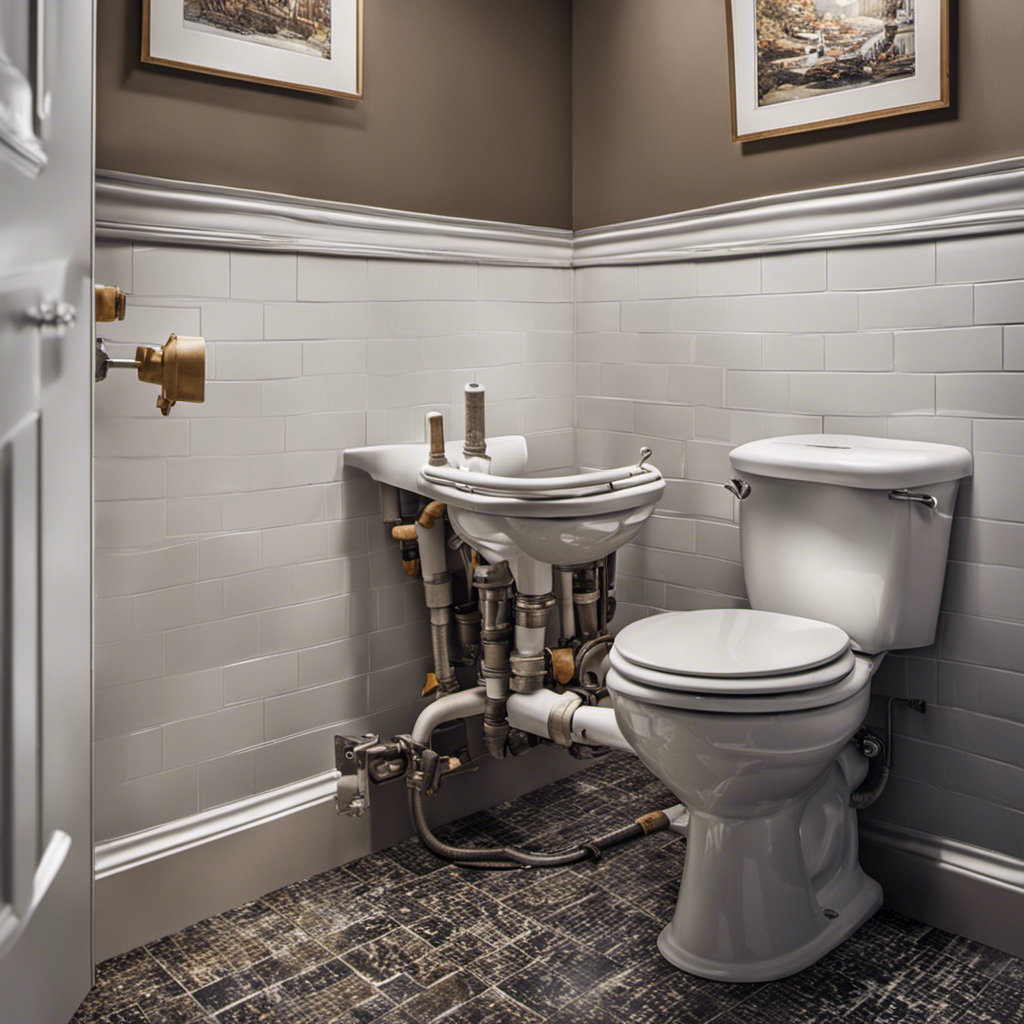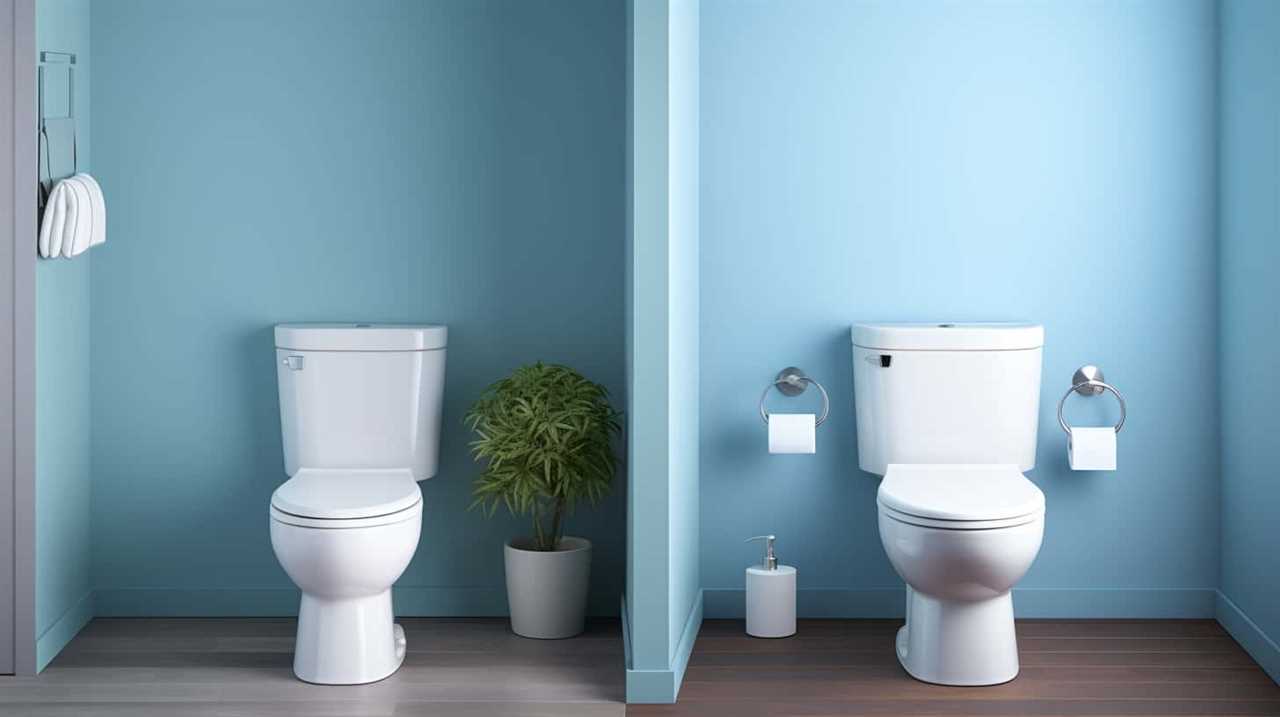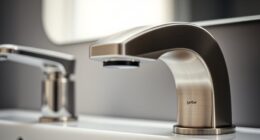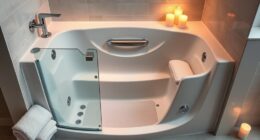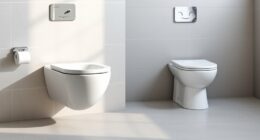As a homeowner, I recently found myself facing the daunting task of replacing my old toilet. Faced with a myriad of options, I quickly realized the importance of understanding the dimensions of a toilet before making a purchase.
From the bowl height to the rough-in size, each measurement plays a crucial role in ensuring a proper fit.
In this article, I will guide you through the process of measuring a toilet, providing you with the knowledge and confidence to make the right choice for your bathroom.
Key Takeaways
- The height of a standard toilet is typically around 15 inches, while comfort height toilets have a height of around 17 to 19 inches.
- The width of most toilets is around 14 to 15 inches, and the depth usually ranges from 26 to 30 inches.
- Measuring the bowl height, seat width, and flush volume are important considerations before purchasing a toilet.
- Determining the rough-in size and water supply location are crucial for ensuring the toilet fits properly in the bathroom.
Standard Toilet Dimensions
To measure the standard dimensions of a toilet, you’ll need to take into account the height, width, and depth.
When it comes to toilet seat dimensions, the height is an important factor to consider. The standard height for a toilet is typically around 15 inches, measured from the floor to the top of the seat. However, there are also comfort height toilets available, which have a height of around 17 to 19 inches.
Moving on to the width, most toilets have a width of around 14 to 15 inches. As for the depth, it usually ranges from 26 to 30 inches.
It’s important to consider the placement of the toilet in your bathroom as well, ensuring there is enough space for comfortable use and easy access.
Measuring the Bowl Height
Make sure you know the bowl height before purchasing it. When measuring the bowl height of a toilet, there are a few key steps to follow.
-
Measure from the floor to the top rim of the bowl. This will give you the overall height of the toilet.
-
Take into consideration the seat height. Measure from the floor to the top of the seat to determine the seat height.
-
Measuring the seat width is also important. Measure the width of the seat from side to side to ensure a comfortable fit.
-
Lastly, determining the flush volume is crucial. Check the specifications or ask the manufacturer to find out the flush volume, which will determine the amount of water used per flush.
Determining Rough-In Size
Determining the rough-in size is essential when selecting a toilet for your bathroom. The rough-in size refers to the distance between the center of the toilet flange and the finished wall.
To measure the rough-in size, start by locating the flange. This is usually a circular opening in the floor where the toilet will be installed. Measure the distance from the center of the flange to the finished wall. This measurement will determine the rough-in size of your toilet.
Additionally, it is important to determine the water supply location. This is typically located behind or to the side of the toilet. Measure the distance from the center of the water supply to the finished wall.
These measurements are crucial in ensuring that the toilet you choose will fit properly in your bathroom.
Measuring the Tank Dimensions
First, you’ll want to check the size of the tank to ensure it fits in your bathroom. To do this, follow these steps:
-
Measure the width of the tank by starting at the left edge and ending at the right edge. This will give you the width dimension.
-
Next, measure the depth of the tank by starting at the back wall and ending at the front edge. This will give you the depth dimension.
-
To measure the height of the tank, start at the base and measure up to the top edge. This will give you the height dimension.
-
Lastly, don’t forget to measure the flush capacity of the tank. This is important to determine how much water is used with each flush.
In addition to the tank dimensions, it’s also crucial to measure the seat dimensions. This includes the width and depth of the seat, ensuring a comfortable fit for the user.
Assessing Overall Space Requirements
To accurately assess the overall space requirements, you’ll need to consider the available room in your bathroom and the necessary clearance around the toilet.
When it comes to optimal toilet placement, there are a few key factors to keep in mind. First, consider the distance between the toilet and any surrounding fixtures or walls. The recommended clearance is usually around 15 inches on either side of the toilet, and at least 18 inches in front. This ensures comfortable access and maneuverability.
Additionally, for small bathroom layouts, it’s crucial to maximize the available space. Consider using a compact toilet model or a wall-mounted toilet to save space. Also, think about the positioning of other bathroom fixtures, such as the sink or shower, to ensure efficient use of space.
Frequently Asked Questions
What Are the Different Types of Toilets Available in the Market?
There are several types of toilets available in the market, ranging from one-piece to two-piece designs. Popular toilet brands include Kohler, American Standard, and Toto. Each brand offers different features and styles to suit individual preferences.
How Do I Choose the Right Toilet for My Bathroom?
To choose the right toilet for your bathroom, consider its design and installation. Look for a style that complements your bathroom decor and make sure it fits the plumbing system in your home.
Are There Any Regulations or Guidelines Regarding Toilet Dimensions in Residential Buildings?
Toilet dimension regulations vary depending on local building codes. It’s important to ensure compliance for residential buildings. Different toilet sizes have pros and cons, such as space-saving options or comfort considerations.
Can I Install a Bidet Seat on Any Toilet Model?
Yes, you can install a bidet seat on most toilet models. However, it’s important to check the compatibility of the bidet seat with your specific toilet model to ensure proper installation and functionality.
How Do I Measure the Water Efficiency of a Toilet?
To measure the water efficiency of a toilet, I calculate its water consumption. By incorporating water-saving technologies, toilets can reduce the amount of water used per flush, thus increasing their efficiency.
Conclusion
In conclusion, when it comes to measuring a toilet, it’s important to consider various dimensions.
By accurately measuring the bowl height, rough-in size, and tank dimensions, you can ensure a proper fit and installation.
Additionally, assessing the overall space requirements will help determine the ideal toilet size for your bathroom.
With these measurements in hand, you can confidently select a toilet that meets your needs and enhances the functionality of your space.
So, don’t hesitate to take out that measuring tape and get started on your toilet measurements today!




